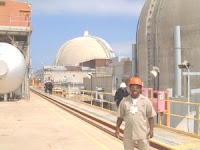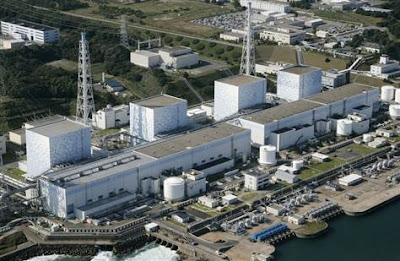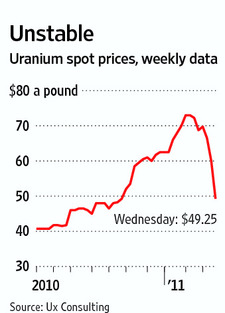Update on Ongoing Monitoring
In response to the ongoing situation in Japan, the U.S. Environmental Protection Agency (EPA) has taken steps to increase the level of nationwide monitoring of milk, precipitation, drinking water, and other potential exposure routes.
EPA conducts radiological monitoring of milk under its RADNET program, while the U.S. Food and Drug Administration has jurisdiction over the safety, labeling and identity of milk and milk products in interstate commerce. States have jurisdiction over those facilities located within their territory.
Results from a screening sample taken March 25 from Spokane, Wash. detected 0.8 pCi/L of iodine-131, which is more than 5,000 times lower than the Derived Intervention Level set by the U.S. Food and Drug Administration. These types of findings are to be expected in the coming days and are far below levels of public health concern, including for infants and children. Iodine-131 has a very short half-life of approximately eight days, and the level detected in milk and milk products is therefore expected to drop relatively quickly.
“Radiation is all around us in our daily lives, and these findings are a minuscule amount compared to what people experience every day. For example, a person would be exposed to low levels of radiation on a round trip cross country flight, watching television, and even from construction materials,” said Patricia Hansen, an FDA senior scientist.
EPA’s recommendation to state and local governments is to continue to coordinate closely with EPA, FDA and CDC. EPA will continue to communicate our nationwide sampling results as they come in.
EPA
FDA
The NFRC was established in 2002 to promote the construction and operation of nuclear reprocessing facilities. NFRC promotes reprocessing commercial spent nuclear fuel that is generated by commercial nuclear power plants.
Reprocessing dramatically reduces the amount of high-level radioactive waste that would have to be stored in a geologic repository. We also support reprocessing plutonium and highly enriched uranium from nuclear warheads into fuel for use in commercial nuclear power plants.
Reprocessing dramatically reduces the amount of high-level radioactive waste that would have to be stored in a geologic repository. We also support reprocessing plutonium and highly enriched uranium from nuclear warheads into fuel for use in commercial nuclear power plants.
Thursday, March 31, 2011
Saturday, March 19, 2011
Spent Fuel Pools Pose Serious Problem at Fukushima Plant
| Norris McDonald with Spent Fuel Pool in background |
By Norris McDonald
I have toured half a dozen spent fuel pools at various nuclear power plants. They always fascinate me. To look down on the boron-laced bluish looking water to observe the spent fuel assemblies below is just one of the most interesting things I have ever done. It never ceases to amaze. Being shown and instructed on how the fuel assemblies are brought into the plant, inserted into the reactor vessel, and ultimated romoved for storage in the spent fuel pools and dry cast outdoor storage is very enlightening.
The fuel rods at all six reactors at the Fukushima Dai-ichi complex contain plutonium. But only six percent of the fuel rods at the plant's Unit 3 were a mixture of plutonium-239 and uranium-235 when it was first put into operation. The fuel in other reactors is only uranium, but even there, plutonium is created during the fission process. Plutonium-239 has a half-life of 25,000 years, meaning it takes that long to lose half of its radioactive potency. Uranium-235 has a half-life of 700 million years. And cesium, which tends to go airborne much more easily, has a half-life of 30 years.
When the pellets of uranium dioxide inside the thin fuel rods are split to create energy in the reactor, they release neutrons that, in turn, create highly radioactive plutonium-239. Some of the U-238 is transformed into PU-239. This plutonium also splits, creating even more energy. By the end of a uranium fuel cycle, 40 percent of the energy produced comes from the splitting of plutonium. The spent fuel rod that remains at the end of the process contains uranium, plutonium, and a mix of other radioactive byproducts.
The Fukushima Dai-ichi site has 3,400 tons of fuel in seven spent fuel pools within the six-reactor plant, including one joint pool storing very old fuel from units 3 and 4. There are 877 tons in five of the reactor cores. Officials have said that the fuel in Unit 4's reactor vessel was transferred to its spent fuel pool when the unit was temporarily shut in November.
Japan has recently built a facility to remove the byproducts and reprocess the plutonium and uranium into a substance called MOX for reuse in its reactors. MOX mixes plutonium or highly enriched uranium from warheads with regular uranium for a blend that can be used in commercial reactors. I toured the LaHague reprocessing facility in France (see photo below) in 2007. Japan's reprocessing plant, in Rokkasho, a village 300 miles (500 kilometers) north of Fukushima, is only starting up, and hasn't yet begun full operation. I also toured the two nuclear reactors in the United States that use MOX fuel.
 |
| Norris Mcdonald (center) with tour group at LaHague nuclear fuel reprocessing facility in France |
The explosions at the 3 containment buildings compromised the spent fuel pools. Now those highly radioactive fuels assemblies are left unshielded by water. The assemblies are not only radioactive, they are extremely hot. This is a real problem for Tokyo Electric Power. I think they will have to bury the site much as the Russians did at Chernobly. Sand, boron, dirt, cement, concrete, steel and everything else they can put on top of the site to block radiation releases into the environment. (FOX News, 3/18/2011)
Thursday, March 17, 2011
Uranium Spot Market Price Dropping: Probably Temporary
Trading in uranium on the spot market totalled about $2.5 billion in 2010. The Fukushima nuclear plant disaster is probably temporarily changing that picture as hedge funds and banks unload their uranium portfolios. Explosions and radiation leaks in Japan have worried some traders too, who are dumping their uranium holdings amid fears that the Japanese crisis could stall expansion of the world's nuclear programs.
Almost three million pounds of uranium have changed hands in the spot market this week, five times more than the average volume. The result is that after an 80% run-up over the past eight months, uranium prices have tumbled. They reached a three-year high of $73 a pound in February, but dropped $13 earlier this week and fell to $49.25 on Wednesday, according to Ux Consulting Company.
At the same time, some utilities and even producers have stepped in to buy the metal in the belief that the demand for more nuclear plants will remain. A total of 65 nuclear units are under construction, mostly in China and Russia. Despite the bearish news in recent days, traders note that more than 400 reactors are still operating, consuming about 180 million pounds of uranium a year. Nuclear power accounts for 14% of global electricity output
Most of the uranium traded in the physical market is in the form of uranium oxide concentrate, which is several steps away from being used as nuclear fuel. After utilities buy uranium on the spot market, these facilities convert the oxide into a gas form of pure uranium, called uranium hexafluoride. The gas, which is radioactive, is then enriched to become nuclear fuel. It is then transported to fabrication centers to convert into a pellet, which is put into a fuel rod that goes into a nuclear reactor.
NFRC believes the current drop represents a short-term impact and the fundamentals for the market are still very strong. (WSJ, 3/17/2011)
Almost three million pounds of uranium have changed hands in the spot market this week, five times more than the average volume. The result is that after an 80% run-up over the past eight months, uranium prices have tumbled. They reached a three-year high of $73 a pound in February, but dropped $13 earlier this week and fell to $49.25 on Wednesday, according to Ux Consulting Company.
At the same time, some utilities and even producers have stepped in to buy the metal in the belief that the demand for more nuclear plants will remain. A total of 65 nuclear units are under construction, mostly in China and Russia. Despite the bearish news in recent days, traders note that more than 400 reactors are still operating, consuming about 180 million pounds of uranium a year. Nuclear power accounts for 14% of global electricity output
Most of the uranium traded in the physical market is in the form of uranium oxide concentrate, which is several steps away from being used as nuclear fuel. After utilities buy uranium on the spot market, these facilities convert the oxide into a gas form of pure uranium, called uranium hexafluoride. The gas, which is radioactive, is then enriched to become nuclear fuel. It is then transported to fabrication centers to convert into a pellet, which is put into a fuel rod that goes into a nuclear reactor.
NFRC believes the current drop represents a short-term impact and the fundamentals for the market are still very strong. (WSJ, 3/17/2011)
Wednesday, March 16, 2011
Fire at Fukushima Unit #4
A fire is out of control at the #4 Unit at the Fukushim Daiishi nuclear power complex. This comes after hydrogen explosions at Units 1, 2 & 3. Plant workers are spraying ocean water laced with boron on those reactors to keep them from melting down.
Radiation hazards are causing massive evacuations near the facility. Residents are being monitored for radiation exposure.
A 6.4 scale earthquake also rocked Tokyo today.
(Various news & agency sources)
Radiation hazards are causing massive evacuations near the facility. Residents are being monitored for radiation exposure.
A 6.4 scale earthquake also rocked Tokyo today.
(Various news & agency sources)
Obama Still Supports Nukes & San Onofre Under Scrutiny
The Obama administration is maintaining its support for nuclear power even after three explosions at crippled nuclear power plants in Japan. Senator Charles Schumer is also standing by nuclear power. However, Senator Joe Lieberman has called for a 'time out' and Congressman Ed Markey is calling for a moratorium on building new plants. House Energy and Commerce Committee Chairman Fred Upton (R-Mich.) is planning legislation aimed at streamlining the approval process for new plants. The Japanese incidents come as a number of power companies have begun applying for Nuclear Regulatory Commission (NRC) licenses to build what would be the first new U.S. reactors in decades. The White House has supported the efforts.
Last year the administration approved $8.3 billion worth of Energy Department loan guarantees for utility giant Southern Co. to add two new reactors to its Vogtle nuclear plant in Georgia — a decision Obama announced personally. But the project would still need an NRC construction and operating license to move ahead. The White House fiscal 2012 budget plan would give the Energy Department another $36 billion in loan guarantee authority for supporting new reactors, in addition to the roughly $10 billion worth the department has remaining.
And Obama used January’s State of the Union speech to float a “clean energy standard” that would require power companies to collectively supply 80 percent of U.S. electricity from various low-carbon sources — including nuclear power — by 2035.
The Center agrees with the position of the Obama administration.
The San Onofre nuclear power plant in San Clemente, California is receiving scrutiny because it sits right on the coast like the Fukushima plant. There are worries that it is vulnerable to a tsunami. NFRC Co-chair Norris McDoanald toured San Onofre on June 6, 2005. San Onofre is about an hour's drive south of Los Angeles and can be seen from Highway 5. It is about a 30 minute drive from San Diego. (The Hill, 3/14/2011)
Last year the administration approved $8.3 billion worth of Energy Department loan guarantees for utility giant Southern Co. to add two new reactors to its Vogtle nuclear plant in Georgia — a decision Obama announced personally. But the project would still need an NRC construction and operating license to move ahead. The White House fiscal 2012 budget plan would give the Energy Department another $36 billion in loan guarantee authority for supporting new reactors, in addition to the roughly $10 billion worth the department has remaining.
And Obama used January’s State of the Union speech to float a “clean energy standard” that would require power companies to collectively supply 80 percent of U.S. electricity from various low-carbon sources — including nuclear power — by 2035.
The Center agrees with the position of the Obama administration.
 |
| Norris McDonald at control room |
 |
| Norris McDonald touring plant |
 |
| San Onofre nuclear power plant |
3rd Explosion at Fukushima Nuclear Complex: Reactor # 2
Tokyo Electric Power Company confirmed an explosion at the No. 2 reactor of its Fukushima Daiichi nuclear plant. According to the Nuclear Safety Agency, the explosion was heard at 6:10 a.m. Tuesday.
(Chicago Sun-Times, 2/13/2011)
(Chicago Sun-Times, 2/13/2011)
Monday, March 14, 2011
2nd Explosion at Nuclear Power Plant in Japan
Japan’s Fukushima Daiichi nuclear complex suffered a second explosion today, destroying an outer building at unit 3. Unit 3, a third reactor at the six-reactor facility, lost its cooling capacity just as Unit 1 did on Saturday. Engineers are flooding both units with seawater and boron to prevent a meltdown.
The Center is concerned about the status of the spent fool pool, which contain used nuclear fuel. These explosions could have compromised that fuel and could have spewed it into the surrounding environment.
Just as with Unit 1, the explosion at unit 3 did not damage the core containment structure. These reactor vessel containment is quite robust, as is evident by remaining intact with a massive structural explosion right around it. Both explosions resulted from a hydrogen build-up. The hydrogen was produced by the exposure of the reactor’s fuel rods and their zirconium alloy casing to hot steam. In normal conditions, the fuel rods would be covered and cooled by water.
The blast injured 11 people, one seriously and Japan’s nuclear agency warned those within 12 miles to stay indoors. Trace amounts of radioactive elements cesium-137 and iodine-131 have been detected outside the plant.
The Fukushima Daiichi unit 3 was built by Toshiba, using a GE design. Last year, the unit began using some reprocessed fuel known as “mox,” a mixture of plutonium oxide and uranium oxide, produced from recycled material from nuclear weapons as part of a program known as “Megatons to Megawatts.” (Wash Post, 3/13/2011)
The Center is concerned about the status of the spent fool pool, which contain used nuclear fuel. These explosions could have compromised that fuel and could have spewed it into the surrounding environment.
Just as with Unit 1, the explosion at unit 3 did not damage the core containment structure. These reactor vessel containment is quite robust, as is evident by remaining intact with a massive structural explosion right around it. Both explosions resulted from a hydrogen build-up. The hydrogen was produced by the exposure of the reactor’s fuel rods and their zirconium alloy casing to hot steam. In normal conditions, the fuel rods would be covered and cooled by water.
The blast injured 11 people, one seriously and Japan’s nuclear agency warned those within 12 miles to stay indoors. Trace amounts of radioactive elements cesium-137 and iodine-131 have been detected outside the plant.
The Fukushima Daiichi unit 3 was built by Toshiba, using a GE design. Last year, the unit began using some reprocessed fuel known as “mox,” a mixture of plutonium oxide and uranium oxide, produced from recycled material from nuclear weapons as part of a program known as “Megatons to Megawatts.” (Wash Post, 3/13/2011)
Explosion At Japanese Nuclear Power Plant
Explosion at Fukushima Daiichi Nuclear Power Station
The 8.9-magnitude earthquake in Japan is putting a spotlight on the nuclear power plants due to fears of a dangerous leak. The Fukushima Daiichi nuclear power plant was crippled by today's earthquake and an explosion at the plant is very serious. Widespread evacuations have been implemented and officials declared a state of emergency. Fukushima Daiichi was built 40 years ago by General Electric.
The explosion was not nuclear [as in fission nuclear bomb explosion], but was created by hydrogen gas mixing with oxygen in the air. A spark ignited the hydrogen. The secondary containment structure around the reactor was partially destroyed, but the reactor itself remains embedded in concrete and steel. The nuclear plant's cooling system failed to function properly after the nuclear reactor lost power and automatically shut down. Japanese officials initially ordered 2,800 people living around the facility to evacuate their homes as a precaution. The Fukushima plant is near the city of Onahama, about 170 miles northeast of Tokyo.
Japan's nuclear safety agency, Japan Nuclear Energy Safety Organization (JNES) has reported that pressure inside one of the boiling water reactors at the Fukushima Daiichi plant had risen well beyond normal levels. Hours after the evacuation order, the government announced that the plant, in northeastern Japan, will release slightly radioactive vapor from the unit to lower the pressure. Pressure was rising inside the Fukushima-Daiichi nuclear reactor after a backup generator also failed and the cooling system was unable to supply water to cool the reactor. The reactor core remains hot even after a shutdown. The explosion is serious, particularly if it involved the containment dome [see video of Japanese nuclear power plant explosion, above].
The Vienna-based U.N. International Atomic Energy Agency is reporting that the four other Japanese nuclear power plants closest to the quake have been safely shut down.

The Fukushima Daiichi nuclear power plant is operated by Tokyo Electric Power Company. They initially evacuated about 1,800 residents living within 2 kilometers (1.2 miles) of the Fukushima Dai-Ichi No. 1 reactor as a precaution. According to the Emergency Information Center of the Nuclear and Industrial Safety Agency, residents within 10 kilometers were told to stay indoors. The earthquake and tsunmai forced the automatic shutdown of 11 of the country's 55 nuclear power plants.
According to the World Nuclear Association, Japanese nuclear power plants are designed to withstand specified earthquake intensities evident in ground motion. The plants are fitted with seismic detectors. If these register ground motions of a set level, systems will be activated to automatically bring the plant to an immediate safe shutdown. (ABC News International, 3/11/2011, Bloomberg, 3/11/2011, WNA, MSNBC, 3/11/2011)
The 8.9-magnitude earthquake in Japan is putting a spotlight on the nuclear power plants due to fears of a dangerous leak. The Fukushima Daiichi nuclear power plant was crippled by today's earthquake and an explosion at the plant is very serious. Widespread evacuations have been implemented and officials declared a state of emergency. Fukushima Daiichi was built 40 years ago by General Electric.
The explosion was not nuclear [as in fission nuclear bomb explosion], but was created by hydrogen gas mixing with oxygen in the air. A spark ignited the hydrogen. The secondary containment structure around the reactor was partially destroyed, but the reactor itself remains embedded in concrete and steel. The nuclear plant's cooling system failed to function properly after the nuclear reactor lost power and automatically shut down. Japanese officials initially ordered 2,800 people living around the facility to evacuate their homes as a precaution. The Fukushima plant is near the city of Onahama, about 170 miles northeast of Tokyo.
Japan's nuclear safety agency, Japan Nuclear Energy Safety Organization (JNES) has reported that pressure inside one of the boiling water reactors at the Fukushima Daiichi plant had risen well beyond normal levels. Hours after the evacuation order, the government announced that the plant, in northeastern Japan, will release slightly radioactive vapor from the unit to lower the pressure. Pressure was rising inside the Fukushima-Daiichi nuclear reactor after a backup generator also failed and the cooling system was unable to supply water to cool the reactor. The reactor core remains hot even after a shutdown. The explosion is serious, particularly if it involved the containment dome [see video of Japanese nuclear power plant explosion, above].
 |
| Fukushima Daiichi nuclear power plant |
The Fukushima Daiichi nuclear power plant is operated by Tokyo Electric Power Company. They initially evacuated about 1,800 residents living within 2 kilometers (1.2 miles) of the Fukushima Dai-Ichi No. 1 reactor as a precaution. According to the Emergency Information Center of the Nuclear and Industrial Safety Agency, residents within 10 kilometers were told to stay indoors. The earthquake and tsunmai forced the automatic shutdown of 11 of the country's 55 nuclear power plants.
According to the World Nuclear Association, Japanese nuclear power plants are designed to withstand specified earthquake intensities evident in ground motion. The plants are fitted with seismic detectors. If these register ground motions of a set level, systems will be activated to automatically bring the plant to an immediate safe shutdown. (ABC News International, 3/11/2011, Bloomberg, 3/11/2011, WNA, MSNBC, 3/11/2011)
Subscribe to:
Posts (Atom)





